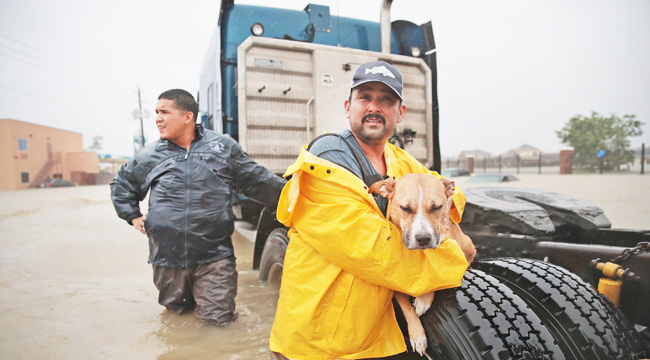
On the twelfth anniversary of Hurricane Katrina’s devastation of New Orleans, southeast Texas (where many former NOLA residents relocated in 2005) remains inundated with continuing rainfall from Tropical Storm Harvey. As a measure of this situation, officials prefer not to measure by “inches” at the moment and are deferring to “feet.” The storm’s death toll remains equally sobering and nebulous — high water swallowed up a family of six without a trace in Houston — and Texas officials fear the worst in terms of body count once the waters finally begin to recede. According to the Associated Press, Houston Police Chief Art Acevedo lamented, “I’m really worried about how many bodies we’re going to find.”
Even worse, the storm is preparing to edge its way toward the Gulf of Mexico to soak up more precipitation before returning for another landfall on Wednesday. This CNN graphic shows the projected path of the coming action.
#Harvey is expected to retreat back to the Gulf of Mexico before heading back toward #Houston Wednesday. #txwx #TropicalStormHarvey pic.twitter.com/32RoWCover
— CNN Weather Center (@CNNweather) August 27, 2017
Since Sunday, over 6,000 residents have been rescued in Houston, but there’s the question of how already-overwhelmed emergency responders can continue to serve demands. The Coast Guard managed to rescue over 3,000 people on Monday, although they’re still receiving 1,000 rescue calls each hour. The Houston Fire Department has taken 2,300 calls for rescue, and Governor Abbott has deployed all 12,000 National Guard troops in the state. Louisiana’s Cajun Navy is also on the job, but all groups will struggle to rescue the many people who remain stranded in or atop their homes.
This ABC News video shows a rescue mission in process on Monday night.
Drone footage shows airboat speeding through flooded streets of Houston after participating in a rescue operation. https://t.co/M54jThCG8n pic.twitter.com/JlveM3qMUN
— ABC News (@ABC) August 29, 2017
Once rescued, residents require shelters, which are largely filled to capacity. Buzzfeed reports on a dire situation from one Houston Red Cross setup:
At the M. O. Campbell Educational Center, in north Houston, an emergency shelter had already packed in 2,000 people, leaving it woefully overcrowded, Jerry Fennell, a Red Cross volunteer helping to run the shelter, told BuzzFeed News that the facility was only set up to hold 500, and had just 200 cots and 400 blankets available. As a result, people were left to sleep on the bare, wet concrete outside the building.
CNN relays word from federal officials who believe a total of 30,000 people will seek refuge in shelters across the Houston area as well as Dallas. Once the waters subside, rebuilding efforts will take years and an untold amount of charitable and government assistance. If you’d like to participate or donate to Harvey recovery operations, here’s a list of ways you may do so.
On Tuesday, President Trump will tour affected areas of southeast Texas, but he’ll reportedly steer clear of Houston for the time being. He’s on the way…
Leaving now for Texas!
— Donald J. Trump (@realDonaldTrump) August 29, 2017
(Via Associated Press, Weather.com, Buzzfeed & CNN)
